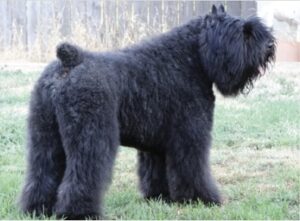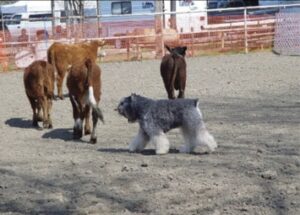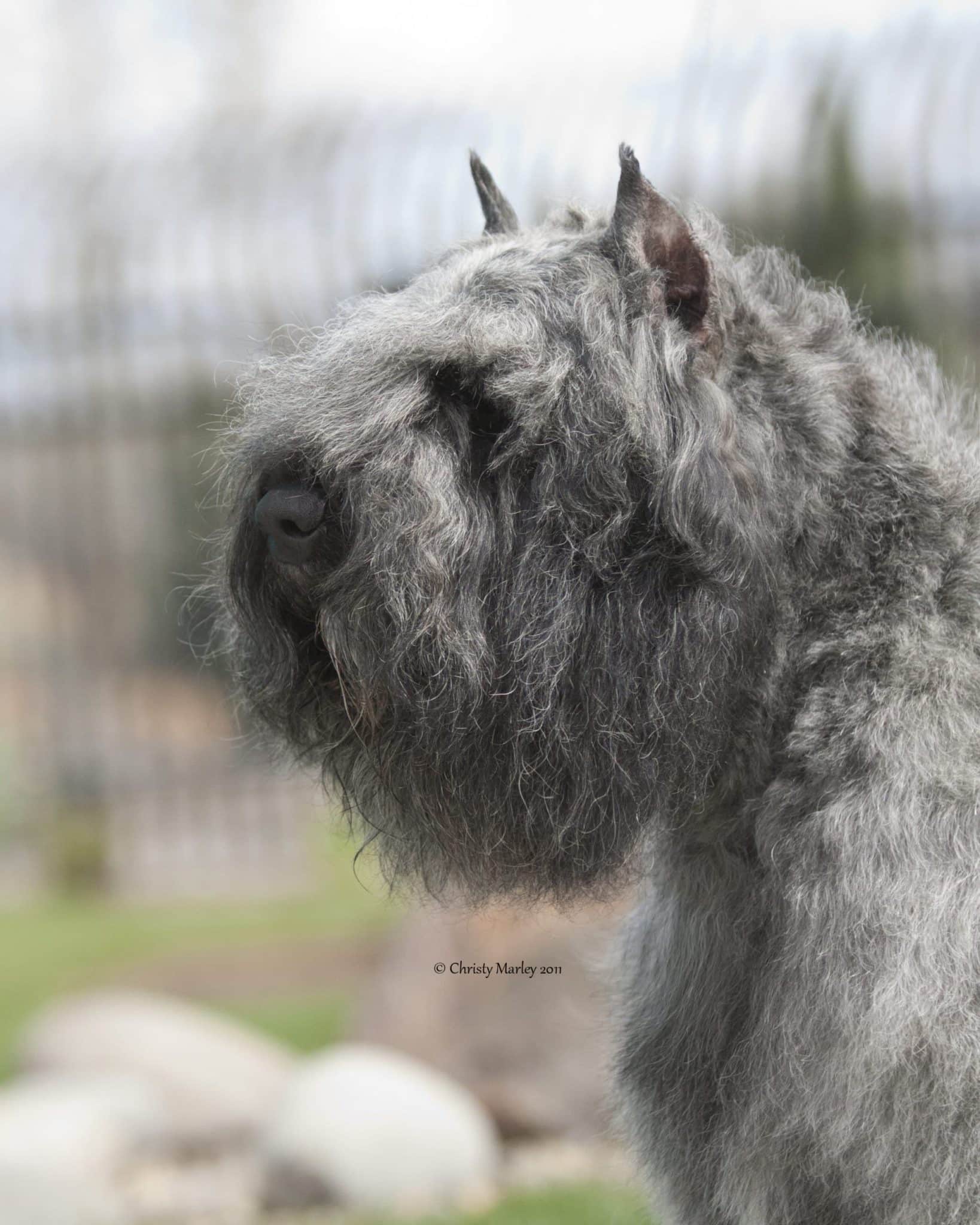Herding Group Coat Requirements: Listed below are the breeds in the Herding Group whose standards contain very specific coat requirements. Coat requirement descriptions have been taken from each standard as they are written.
Herding Group:
Australian Shepherd – “… medium texture… weather resistant and of medium length. The undercoat varies in quantity with variation in climate… Non-typical coats are severe faults.”
Bearded Collie – “… outer coat is flat, harsh, strong, and shaggy…” The severe fault is a “…long, silky coat. Trimmed or sculpted coat.”
Belgian Malinois – “… straight, hard enough to be weather resistant…”
Beauceron – “… coat is… course, dense…” DQ – “Shaggy Coat.”
Bouvier Des Flandres – “A tousled double coat… outer hairs are rough and harsh… Topcoat must be harsh to the touch… A flat coat, denoting lack of undercoat is a serious fault…” A “silky or woolly coat… is a fault.”
Briard – “The outer coat is coarse, hard and dry (making a dry rasping sound between the fingers).”
Canaan Dog – “Outer coat-straight, harsh, flat-lying…”
Rough Collie – “The well-fitting, the properly-textured coat is the crowning glory of the rough variety of Collie… The outer coat is straight and harsh to the touch. A soft, open outer coat… regardless of quantity is penalized… The texture, quantity, and the extent to which the coat “fits the dog” are important points.”
German Shepherd Dog – “… double coat of medium length… hair straight, harsh and lying close to the body… Faults in coat include soft, silky, too long outer coat, woolly, curly, and open coat.”
Norwegian Buhund – “Outer coat is thick and hard…”
Old English Sheepdog – “Coat… of a good hard texture… Quality and texture of coat to be considered above mere profuseness. Softness or flatness of coat to be considered a fault.”
Shetland Sheepdog – “… outer coat consisting of long, straight, harsh hair… Faults-…wavy, curly, soft or silky.”
Swedish Vallhund – “Medium length hair, harsh… Fluffy coats… are a serious fault. The following faults are to be so severely penalized as to effectively eliminate the dog from the competition: Fluffy Coat…”
Herding Group Coat Requirements
Hair… is it the sole defining characteristic of a Herding breed or is it one key element among other essential qualities? A defining characteristic by direct definition means that without possessing this particular type component, the breed ceases to be the breed. Most will agree that the Maltese coat is his defining characteristic. The white, silky hair makes him what he is. A Yorkshire Terrier is not a Yorkie without the luxurious, single-coated, dark steel blue curtain of hair. These are examples of dogs whose sole function on the planet is to look the part and be a home companion, even though the one breed was originally bred down from farm ratters; this no longer being the attraction to own one.
Bouviers have the distinction of being one of the highest functioning AKC-recognized breeds, anatomically designed for great diversity in their duties and responsibilities. This demands a variety of essential physical characteristics in order to perform vital tasks. An efficient, well-constructed body means the difference between a tireless farm worker and a porch pooch. Compact, short-coupled, well-boned, deep-chested, and proportionately balanced front to rear is essential for maximum functional efficiency.
 Coat quality and texture are some of the physical components that enable the dog to more effectively perform his outside duties in varying weather conditions and climates. In hot, dry, and humid areas, the cuticles of the hair shaft and the topcoat open to allow air to flow to the skin and cool the body. (Many of us complain about our “fuzzy hair” in hot humid weather.) In cold, wet weather conditions, guard hair and undercoat act as a seal, and close to protect the skin from moisture and warm the body. The skin and coat are the thermal protectors that function as a sensor mechanism to shield and aid in survival in harsh conditions.
Coat quality and texture are some of the physical components that enable the dog to more effectively perform his outside duties in varying weather conditions and climates. In hot, dry, and humid areas, the cuticles of the hair shaft and the topcoat open to allow air to flow to the skin and cool the body. (Many of us complain about our “fuzzy hair” in hot humid weather.) In cold, wet weather conditions, guard hair and undercoat act as a seal, and close to protect the skin from moisture and warm the body. The skin and coat are the thermal protectors that function as a sensor mechanism to shield and aid in survival in harsh conditions.
Upon touch, one may expect to feel a variation and a range of texture qualities depending on the weather and the temperature. In evaluating the characteristics of hair, one must remember that it is a living organism on the body of a living thing for a specific reason… protection. It acts and feels differently in various climate conditions because it is doing its job. A fur pelt will feel the same to the touch in all conditions as it has been stripped from the body of an animal. The coat is no longer living. Why, when evaluating fur on a live animal, are we expecting to feel the same thing in all weather conditions? It would not be functioning properly if the texture was the same in tepid humidity as opposed to a dry, 50-degree climatized air conditioning.
 The ratio of guard hair to undercoat is an important consideration in the evaluation. In humans, each hair follicle yields one strand of hair. In canines, one hair follicle is possessed of both properties—undercoat and guard hair. The density of the coat is of crucial consideration. If the coat is comprised of silky or woolly texture and quality, it will not have the ability to provide protection, no matter what the conditions are. The poor quality coat can be a genetic trait, or it may be indicative of a nutritional deficiency or a coat that has not been cared for properly; essentially, poor condition. In both cases, this would be a consideration for evaluation in a show ring by a judge.
The ratio of guard hair to undercoat is an important consideration in the evaluation. In humans, each hair follicle yields one strand of hair. In canines, one hair follicle is possessed of both properties—undercoat and guard hair. The density of the coat is of crucial consideration. If the coat is comprised of silky or woolly texture and quality, it will not have the ability to provide protection, no matter what the conditions are. The poor quality coat can be a genetic trait, or it may be indicative of a nutritional deficiency or a coat that has not been cared for properly; essentially, poor condition. In both cases, this would be a consideration for evaluation in a show ring by a judge.
Given the variables of coat quality and the external conditions that affect it, should the undue emphasis be placed on it to the exclusion of other physical characteristics in the show ring? Why does it seem that many discussions with a judge in regards to the evaluation of a Bouvier START with only the coat; its texture and trim without mere mention of any structural components? Bouviers are not the only Herding breed with a very specific coat texture requirement as specified in its breed standard (see standards listed previously), yet very seldom do we hear judges say that the reason for not awarding an otherwise quality Briard a ribbon was because the hair failed a make a dry rasping sound when rubbed between the fingers, and was not hard and dry. There is no question that this feature of the Briard is inherently important, but it is not the first thing one typically remarks on. It would appear that the Bouvier seems to be the only herder whose primary consideration is a fur pelt held up by four legs and a spine to the sacrifice of other functioning aspects. If ribbons are to be awarded based solely on this, then a study of what a correct Bouvier coat is made up of (and the properties that make it so and in which climate conditions) is necessary. Bouviers are not hard-coated Terriers.

On exam, the initial visual assessment of the dog should give one an impression as to whether the coat’s density would have the capability to protect the body in various weather conditions. A hands-on inspection should confirm texture and the ratio of undercoat to guard hair. As far as the outline of the body in regards to the trim, on stepping back several feet, one should be able to notice the tips or ends of the guard hair rather than a uniformly blunt-cut hair shaft that is more typical of a Bichon or a Poodle… breeds that do not require a harsh, tousled coat. Do not mistake a “tousled” coat with an “open” coat. An open coat lacks a sufficient undercoat to provide protection. This does not mean that the hair cannot be stripped, mucked-out, and trimmed to create the pleasing body outline of a show ring finish.
Learning how to correctly evaluate an all-weather coat—and becoming familiar with the properties that make it so—is the key to the appreciation of the Herding breeds.
SHOWSIGHT magazine is deeply saddened to report the passing of AKC Executive Field Representative, Sue Vroom. We are indebted to the former professional handler for her many contributions to this publication and to the sport of dogs. Our sincere condolences are offered to her family, friends, and colleagues.
Hair of the Dog: Herding Group Coat Requirements



 Coat quality and texture are some of the physical components that enable the dog to more effectively perform his outside duties in varying weather conditions and climates. In hot, dry, and humid areas, the cuticles of the hair shaft and the topcoat open to allow air to flow to the skin and cool the body. (Many of us complain about our “fuzzy hair” in hot humid weather.) In cold, wet weather conditions, guard hair and undercoat act as a seal, and close to protect the skin from moisture and warm the body. The skin and coat are the thermal protectors that function as a sensor mechanism to shield and aid in survival in harsh conditions.
Coat quality and texture are some of the physical components that enable the dog to more effectively perform his outside duties in varying weather conditions and climates. In hot, dry, and humid areas, the cuticles of the hair shaft and the topcoat open to allow air to flow to the skin and cool the body. (Many of us complain about our “fuzzy hair” in hot humid weather.) In cold, wet weather conditions, guard hair and undercoat act as a seal, and close to protect the skin from moisture and warm the body. The skin and coat are the thermal protectors that function as a sensor mechanism to shield and aid in survival in harsh conditions. The ratio of guard hair to undercoat is an important consideration in the evaluation. In humans, each hair follicle yields one strand of hair. In canines, one hair follicle is possessed of both properties—undercoat and guard hair. The density of the coat is of crucial consideration. If the coat is comprised of silky or woolly texture and quality, it will not have the ability to provide protection, no matter what the conditions are. The poor quality coat can be a genetic trait, or it may be indicative of a nutritional deficiency or a coat that has not been cared for properly; essentially, poor condition. In both cases, this would be a consideration for evaluation in a show ring by a judge.
The ratio of guard hair to undercoat is an important consideration in the evaluation. In humans, each hair follicle yields one strand of hair. In canines, one hair follicle is possessed of both properties—undercoat and guard hair. The density of the coat is of crucial consideration. If the coat is comprised of silky or woolly texture and quality, it will not have the ability to provide protection, no matter what the conditions are. The poor quality coat can be a genetic trait, or it may be indicative of a nutritional deficiency or a coat that has not been cared for properly; essentially, poor condition. In both cases, this would be a consideration for evaluation in a show ring by a judge.






